Beginnings and Ends, Part 1
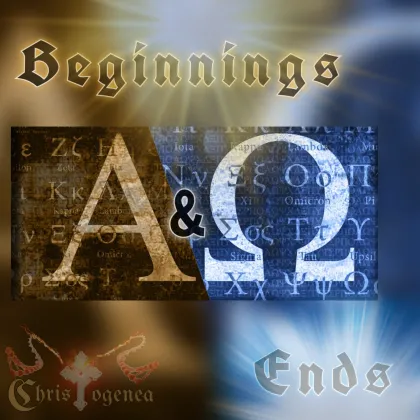
This was originally recorded June 5th, 2016.
Sorry, no transcripts or notes for these discussions are available. Everything said here is certainly documented somewhere else at Christogenea.
Christogenea is 100% reader supported. If you find value in our work, please contribute and help to keep it going! See our Contact Page for more information!

This was originally recorded June 5th, 2016.
Sorry, no transcripts or notes for these discussions are available. Everything said here is certainly documented somewhere else at Christogenea.
The Prophecy of Zechariah – Part 4: Sin and Punishment
We have already presented six chapters of this book of the prophecy of Zechariah, and we hope to have fully established that Zechariah was a Christian prophet in many scriptural aspects. First, he prophesied the rebuilding of the temple in Jerusalem as a type for the rebuilding of the house of God in His people Israel, which is the ultimate purpose of the 70-weeks Kingdom in Judaea. Then, his prophecy uses the first high priest of that rebuilt temple, Jeshua, or Joshua, as a type for Yahshua Christ, the coming Messiah who would be the ultimate high priest of His people. Furthermore, he used Zerubbabel, the first governor of Jerusalem as it was going to be rebuilt, as a type for Christ as Governor over His people. The seven-branched candlestick of Zechariah’s vision was a prophecy foreshadowing the messages to the seven Christian assemblies of the Revelation, and the vision of the two witnesses, or olive trees, which feed their oil to those candlesticks informs us that those assemblies consist of the people of the houses of Israel and Judah. The very purpose of the 70-weeks Kingdom was to achieve the reconciliation of Yahweh God with Israel, and all of these circumstances in its founding were employed by the prophet as allegories representing that purpose, which was ultimately fulfilled in Christ.
An underlying theme of these first few chapters is found in the references to the tribes of Israel. In chapter 1 there is a reference to “the horns which have scattered Judah, Israel, and Jerusalem.” In chapter 2 there is a plea to scattered Israel, where it says “Deliver thyself, O Zion, that dwellest with the daughter of Babylon”, and in this case Babylon is symbolic for the captivity of all Israel. That plea is followed by a promise: “10 Sing and rejoice, O daughter of Zion: for, lo, I come, and I will dwell in the midst of thee, saith the LORD. 11 And many nations shall be joined to the LORD in that day, and shall be my people: and I will dwell in the midst of thee, and thou shalt know that the LORD of hosts hath sent me unto thee. 12 And the LORD shall inherit Judah his portion in the holy land, and shall choose Jerusalem again.” This was fulfilled in Yahshua Christ, who told His opponents that “I am He”. The proof is found in the fact that scattered Israel turned to Christ, proving that “thou shalt know that the LORD of hosts hath sent me unto thee.” From similar visions in the words of other prophets we have explained that this too is a prophecy of Christ and the deliverance of His people Israel from captivity: that the many nations joined to Yahweh are the nations which the children of Israel were prophesied to become in the course of their captivity, and that they were joined to Yahweh in Christ when the nations of Europe, the descendants of the ancient Israelites, ultimately accepted Christianity.
Reflections on the alleged Whorlando Homocaust [the supposed recent mass shooting of sodomites in Orlando] and the state of Christendom today, with Pastor Mark Downey. Finck's comments were based on his more recent article, There is no Pulse. Mark read from his recent sermon, Whorlando Changes Nothing
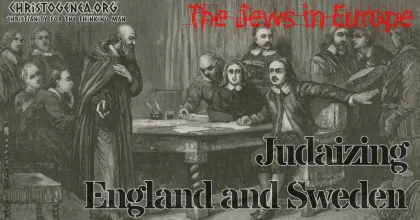
The Jews in Europe: Judaizing England and Sweden
Before we proceed with a short summary of the Jewish presence and influence in 17th century England, we should take a brief moment to look at the Jewish presence and influence in contemporary Sweden. Perhaps the Swedes missed an opportunity in saving England from Judaism, at least temporarily, when Christina the Swedish queen rejected the advances of Manasseh ben Israel. But in truth, she had already had enough Jews of her own.
We do not like to use Jewish sources for our studies, and we strongly dislike quoting Jews unless we are quoting them critically. But on some topics relating to Jews, some of their writers are worthy of quoting, so long as we can corroborate their statements independently. So the following excerpt is from a book written by a Jew named David S. Katz, entitled Menasseh ben Israel’s Mission to Queen Christina of Sweden, 1651 - 1655:
With perfect hindsight, one often sees Menasseh ben Israel’s career as leading inexorably to his mission to Oliver Cromwell in 1655, when he came to London to plead for the readmission of the Jews to England, nearly four centuries after their expulsion. At least this is how the events of the 1650s appear if one begins with the Whitehall Conference of 1655 and follows the thread back to the first tentative overtures toward England from Amsterdam. Even after the publication of The Hope of Israel in 1650, however, it was not apparent that Menasseh would soon be devoting himself to the cause of Anglo-Jewry. On the contrary, it was immediately after the appearance of the rabbi’s influential book that he began maneuvering for a place in the retinue of the notorious Christina, queen of Sweden. Only after he failed to obtain a position among her band of foreign scholars did Menasseh devote himself wholeheartedly to the readmission of the Jews to England. Other Jews had managed to win themselves a place in Christina’s circle. so Menasseh’s scheme was quite practicable. If Queen Christina had accepted the rabbi’s proposals with more alacrity, the history of seventeenth century Anglo-Jewry would have been very different indeed.
The Prophecy of Zechariah – Part 3, The House of God
Having presented the first three chapters of Zechariah, we hope to have established the fact that there are two perspectives to fully interpreting the words of the prophet and realizing the fulfillment of his prophecy. These we have termed the near vision, which is the immediate application of his prophecy to the rebuilding of the second temple and the initiation of the 70-weeks Kingdom, and the far vision, or the transcendental fulfillment of the prophecy to the birth and ministry of the Christ and the building of His House, which is both His temporal body and the body of His collective people Israel. We would also assert that the entire purpose of the 70-weeks Kingdom was to realize the fulfillment of the far vision, as the Word of God establishes for us both here and in Daniel chapter 9.
Now in Zechariah chapter 4, Zerubbabel, the governor of Jerusalem during the building of the second temple and the high priesthood of Joshua, is only mentioned several times. His name means sown in Babel, or Babylon, and that is important in relation to what we hope to demonstrate is the meaning of this chapter. Especially since the Hebrew word babel also means confusion, and more specifically confusion by mixing. This in itself is a prophecy of ancient Judaea, the birth of Christ and the modern understanding of the origins of both the Gospel and the people of Christ. So the redemption of the children of Israel was sown in confusion.
A presentation of Born Under Contract, a paper written by Clifton Emahiser
Here we are going to present an article written perhaps 12 years ago by Clifton Emahiser, which is entitled Born Under Contract. This article aims to demonstrate that the promises made to the Old Testament patriarchs by Yahweh had confined all of their legitimate descendants under a covenant, which is essentially a contract, and that they themselves would have no choice in the matter. In the ancient world, a father had property rights and the power to make such life and death commitments over his offspring, and the offspring had no say in the matter. So, for example, Abraham had an inherent right to place his son Isaac on the altar and sacrifice him to the will of his God. Now, I said legitimate descendants, because the contract was accompanied by a law which forbade illegitimate descendants from reaping its benefits.
Here the sophists and scoffers may say something like, ‘oh, that is not true, the law was not given until Mount Sinai.’ However the Scripture proves otherwise. Abraham was chosen by Yahweh, as we read in Genesis chapter 26: “5 Because that Abraham obeyed my voice, and kept my charge, my commandments, my statutes, and my laws.” So a little more must have been given to Abraham than what the Scripture describes. The proof is in the fact that Abraham had every concern over who his son Isaac, who would inherit the covenant, would marry. This is found in Genesis chapter 24: “1 And Abraham was old, and well stricken in age: and the LORD had blessed Abraham in all things. 2 And Abraham said unto his eldest servant of his house, that ruled over all that he had, Put, I pray thee, thy hand under my thigh: 3 And I will make thee swear by the LORD, the God of heaven, and the God of the earth, that thou shalt not take a wife unto my son of the daughters of the Canaanites, among whom I dwell: 4 But thou shalt go unto my country, and to my kindred, and take a wife unto my son Isaac. 5 And the servant said unto him, Peradventure the woman will not be willing to follow me unto this land: must I needs bring thy son again unto the land from whence thou camest? 6 And Abraham said unto him, Beware thou that thou bring not my son thither again.” A generation later, Esau had disregard for this, and his mother made certain that it cost him his share in the inheritance of Jacob. She is recorded in Genesis chapter 27 as having exclaimed: “46 And Rebekah said to Isaac, I am weary of my life because of the daughters of Heth: if Jacob take a wife of the daughters of Heth, such as these which are of the daughters of the land, what good shall my life do me?” To this we see Isaac’s response, in Genesis chapter 28: “1 And Isaac called Jacob, and blessed him, and charged him, and said unto him, Thou shalt not take a wife of the daughters of Canaan.” So the patriarchs, and the matriarchs, were properly racists.
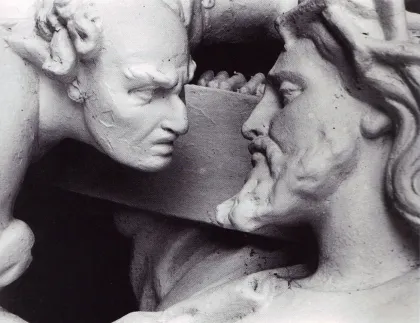
The Prophecy of Zechariah – Part 2, Jesus and Satan
Presenting the first two chapters of Zechariah, we saw that the prophet began writing around the start of the building of the second temple in the days of Zerubbabel, about 520 BC. While his prophecy had a meaning with an immediate application in his own time, regarding the building of the temple, it also has far-reaching implications related to the very purpose of the 70-weeks kingdom, which is what we call Judaea as it was in the inter-testamental period. We hope to further establish the proofs of that assertion here, presenting Zechariah chapter 3.
This period which we prefer to describe as the 70-weeks kingdom, from another prophecy which describes it in Daniel chapter 9, is also referred to as the second temple period. However that label is not quite accurate. According to Ezra, the second temple took only four years to build. The temple of the time of Christ was actually the third temple, Herod’s temple, as the second temple was rebuilt from the foundations up. That is how the Judaean historian Flavius Josephus described it, and the building of that third temple is mentioned in John chapter 2 where it is said that the project took 46 years to complete.
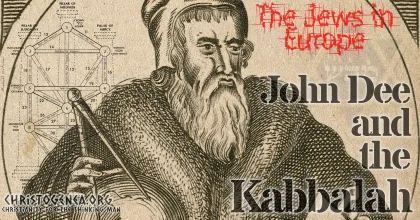
Here we are going to continue to present some aspects of the life of John Dee as they were recorded in a biography of the English alchemist, mathematician, and mystic. Our primary source is the biography of John Dee which was written by Charlotte Fell Smith and published in 1909. By the time we are finished, we hope to establish that John Dee was an advocate of the Jewish Kabbalah, through which he had introduced Jewish mysticism into the intellectual circles of 16th century England, just as Johann Reuchlin had done in Germany a few decades earlier. As we also hope to illustrate, the impact this would have on history cannot be overstated.
The year is 1583, and the Polish Prince Laski is in England. A French ambassador of the time speculated that Laski was in England to persuade the Muscovy Company to stop selling arms to the Russians. He certainly did not go merely to see John Dee. But Laski was also an alchemist, and very interested in John Dee, whom he insisted on meeting and being entertained by quite frequently almost as soon as he had arrived in London. Charlotte Fell Smith basically dismisses the idea that John Dee was a spy. In chapter 13 of her biography (pp. 168-169) she says “Dee's letters to Walsingham, with their veiled allusions to secret affairs, form one of the grounds upon which the supposition has been based that he was employed by the Queen's minister as a secret spy and diplomatic agent abroad, and that his kabbalistic diagrams contained a cipher. An elaborate theory was constructed to support this contention.” However, when considering the possibility that in his later trips abroad John Dee was acting as a spy for the English court, we must remember that the Queen herself had financed Dee’s ability to entertain Prince Laski and his entourage. So Elizabeth seemed to have encouraged Dee’s developing a relationship with Laski. But the financing did not endure. It must also be noted, that in her biography Charlotte Fell Smith had several times already described Dee’s troubles securing his diaries in a household replete with servants and fellow-workers. Those fellow-workers, namely his scryer Edward Kelley, had often caused Dee troubles, and therefore if Dee were a spy, he had every reason not to include the information in his biography. So while we do not accept much of the conjecture of the conspiracy theorists, we cannot rule out the possibility that Elizabeth encouraged Dee’s travels abroad so that he may report back to her any information he may gather. However on the other hand, Elizabeth being a long-time friend and patron of John Dee, that well-known relationship which he had with the English queen must have preceded him, and it would only have been natural for him to report to her anything which he had seen abroad.
The Prophecy of Zechariah – Part 1, Visions Near and Far
The writing of the book of Zechariah the prophet can be dated rather accurately to begin about 520 BC, during the reign of the Persian king known as Darius the Great. Zechariah was one of three post-captivity prophets whose writing we have in our Bibles. The others are Haggai and Malachi. According to Haggai himself, the written records of his prophecy were initiated just over two months before those of Zechariah, at the very beginning of the sixth month in the second year of Darius. While the book of Malachi is not dated, from internal evidence it was clearly written some time after both Haggai and Zechariah, as the Levitical priesthood which was reestablished in the time of the first two second-temple prophets was being corrupted in the time of Malachi. Therefore Malachi may have been written as late as the events described in Ezra chapters 9 and 10, and possibly even later.
As we more fully demonstrate in an article at Christogenea entitled Notes Concerning Daniel's 70 Weeks Prophecy, the mission of Nehemiah preceded that of Ezra by many decades. The first captives, unrecorded by Scripture, may have returned to Jerusalem some time after 539 BC, when Cyrus had conquered Babylon. Evidently, some time during this period, some rebuilding in Jerusalem may have begun but was never completely finished. Cambyses, the son and successor of Cyrus who ruled from 529 to 522 BC, was a difficult man. Upon complaints from the Samaritans and others, he had ordered any building activity at Jerusalem to cease. This was recorded by Flavius Josephus. After Cambyses had died from a wound in battle, Darius became King of Persia, in 522 or 521 BC, and by 520 the rebuilding in Jerusalem had commenced. The opening verses of Haggai the prophet records that the temple was rebuilt at this very time.

The Jews in Europe: John Dee and the Kabbalah, Part 1
Our purpose here, before beginning a presentation of The Protocols of the Learned Elders of Zion, or as we like to more appropriately title them, The Protocols of Satan, is to demonstrate that Kabbalistic thought had permeated Britain and was in a position where it could captivate the minds of many an unsuspecting Englishman right at a time when scientific thought and liberty of conscience were becoming popular ideas in the concurrent wars of religious reformation of Europe. This kabbalistic thought would lend to the formation of modern Freemasonry and the secret societies of Europe from which all of the subsequent revolutions were launched which overturned Christian society and resulted in world Jewish supremacy.
A child was being born, and Satan could not kill it, so he persecuted and made war against its mother. In the Protocols, the objectives of the Jews and the agenda which to a large degree has been executed with the help of the lodges of Freemasonry come together as one, and are fully expressed.
To introduce the Kabbalah as a godly authority to otherwise Christian scholars is tantamount to giving the Jewish rabbis religious authority over countless Christian minds. This is what was happening in the Freemasonic lodges of Europe through the 18th and 19th centuries, and it is still ongoing today, whether or not lower-level Freemasons and its initiates realize this objective. That is because it is done not in the name of religion, although religion plays a role in the Freemasonic mantras and rituals, nor in the name of politics, although the end result is political. Rather, it is done in the name of science and scientific inquiry.
Paul’s Second Epistle to the Thessalonians, Part 3: The Faith is not for All (οὐ γὰρ πάντων ἡ πίστις)
In his first epistle to the Thessalonians Paul had discussed the persecution of Christians by those Jews who stood in opposition to the Gospel of Christ. In the last chapter of that epistle he mentioned the promise of the ultimate destruction of those enemies of Christ. Here in his second epistle Paul has elaborated on that very theme, and has more accurately identified the nature of those enemies whom he had mentioned in the first letter, “those who killed both Prince Yahshua and the prophets, and banished us, and are not pleasing to Yahweh, and contrary to all men”, as he had described them in 1 Thessalonians chapter 2.
Here in 2 Thessalonians chapter 2, Paul has explicitly stated that, as he was writing this epistle, that apostasy had already come, that there was already a “man of lawlessness”, which he characterized as the “son of destruction”, operating “in accordance with the operation of the Adversary”, or Satan. We know that this was Paul’s intended meaning because, as we have explained at length, while he described these things he had used present tense verbs, verbs which describe presently occurring phenomena, as well as aorist tense verbs describing actions which were already initiated relative to that presently occurring phenomena.
The grammar of Paul’s statements do not permit one to imagine that the men and actions which he had described would materialize at some point far off in the future. Using present tense verbs, Paul was speaking of someone who already at his own time was “opposing and exalting himself above everything said to be a god or an object of worship, and so he is seated in the temple of Yahweh, representing himself that he is a god.”
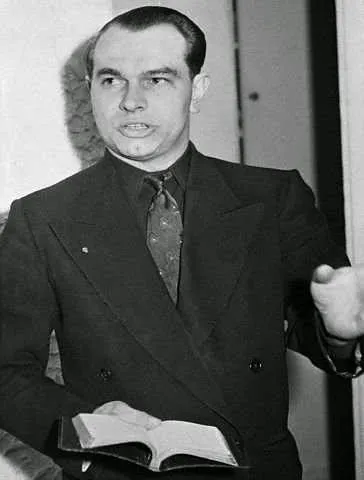
A Critique of Wesley Swift, and why we must preserve his work: so first we explain our motives and methods at Christogenea.
I want to give people the opportunity to understand some of the logic behind Christogenea and how it evolved, so I have to sort of start from the beginning. Everything we do is carefully considered, whether we succeed or we fail. I remember telling Clifton Emahiser in a phone conversation, perhaps as early as 2005 or 2006, that one day I would put all of his material on a website of his own. At that time I wanted to call it john844.org. Of course, I was still in prison. There is currently a john844.org website which I created, but I did not use it for the purposes I had originally intended and in its current state it is still not complete. Then a short time later I thought of what I thought was a better term, and, so far as I remember, I kept it to myself.
When I was released from prison in December of 2008, I had a concept for a website for my own writing that I was going to call either Christogenea or Christogenos. I eventually settled on the former because I thought it better resembled its meaning in English, but I still like Christogenos a little more. I continue to retain ownership of both domain names.
I really thought that Christogenea would just be a small blog and a place for my essays and translations, and that I would keep my promise to Clifton. I never had any idea that it would grow into a collection of websites with over 12,000 pages, not counting the forum. I never imagined there would be a forum. By the end of April of 2009, I accomplished those things which I originally set out to do.
Paul’s Second Epistle to the Thessalonians, Part 2: Satan Revealed
The writing of book of Zechariah the prophet can be dated rather accurately to begin about 520 BC, during the reign of the Persian king known as Darius the Great. On the surface, the subject of Zechariah’s prophecy appears to be the rebuilding of Jerusalem in Judaea, as it is presented at the time of the building of the second temple where there is also an actual high priest with the name of Joshua. His is the same name, in its common Medieval English form, as Joshua the son of Nun from the time of Moses. But it is also the same name as the personal name of Yahshua the Messiah, who is more commonly known as Jesus Christ. Zerubbabel is also mentioned in Zechariah’s prophecy, several times in chapter 4. His name means sown in Babel, or Babylon, and he was the governor of Jerusalem at the time of the return of the remnant and the building of the second temple.
While the immediate subject in Zechariah appears to be Jerusalem in Judaea, that is not at all the ultimate purpose of the prophecy. Such is the nature of dual prophecies, that they are given in a manner which has both an immediate application and an ultimate meaning, The ultimate purpose of these early chapters of the prophecy of Zechariah is to describe the reconciliation of the people of Israel in their dispersions, the condition of their true High Priest before their sins are removed, and the propitiation which that Priest, Yahshua Christ, makes on their behalf. Joshua, the high priest of Zechariah’s time, is only a type for Yahshua Christ. Jerusalem, the actual city, is only a type for the true Jerusalem, the City of God come down from heaven, and the rebuilt temple is a type for the restored Body of Christ found in those of His people who are willing to hearken in obedience to Him.
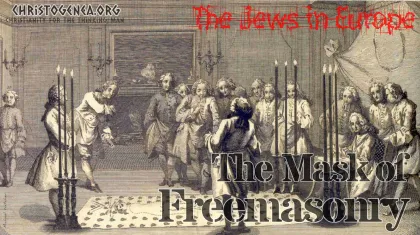
To begin this evening’s program, I want to repeat a paragraph which we had presented in our last segment of this series, from pages 333-335 of The Freemason’s Manual, written by one Jeremiah How and published in 1881. We are doing this first to buttress the claims of our source volume for this series, The Plot Against the Church, which asserts that Freemasonry is a product of World Jewry and has been used as a vehicle to subvert Western Civilization, and also to reiterate my assertions concerning any connections alleged between the more ancient Knight’s Templar and Freemasonry. Here Jeremiah How is writing in reference to the so-called “Royal, Exalted, Religious and Military Order of Masonic Knights Templar”, which is evidently an order and a degree within Freemasonry.
There is much difference of opinion as to the origin of this degree of the Masonic Institution, and without attempting to show that the form of conferring the degree is identical with that of the gallant and devoted soldier-monks of the Crusades, it cannot be controverted that their Institution possessed some features of similarity to Freemasonry. The connexion between the Knights Templar and the Masonic Institution has been repeatedly asserted by the friends and enemies of both. Brother Lawrie says, ‘We know the Knights Templar not only possessed the mysteries, but performed the ceremonies, and inculcated the duties of Freemasons;’ and he attributes the dissolution of the Order to the discovery of their being Freemasons, and assembling in secret to practise the rites of the Order. He endeavours to show that they were initiated into the Order by the Druses, a Syrian fraternity which existed at that date, and indeed now continues.
In a French MS. ritual of about 1780, in the degree of Black and White Eagle (30°), the transmission of Free masonry by the Templars is most positively asserted. The history of the Templars and their persecution is minutely described in the closing address, and the Grand Commander adds, ‘This is, my illustrious brother, how and by whom, Masonry is derived, and has been transmitted to us. You are now a Knight Templar, and on a level with them.’
We are going to reassert, that it is our opinion that the whole story about Freemasonry getting into Europe through the Knights Templar is an absolute fabrication. It is a cover story shielding the Jews from exposure as the real force behind Freemasonry. If it were true, it would suppose that Freemasonry had a more noble origin than the Medieval scholars, Jewish interlopers and outright frauds who were promoting the use of the Kabbalah to Christians. But even the sect of the Druze is founded upon Judaism, and modern Druze today even sit in the Israeli parliament in Palestine. Furthermore, the Knight’s Templar allegedly became wealthy through a mixed system of donations and usury, a vocation rather exclusive to the Jews in 13th century France. There may have been similarities between the Templars and the Masons only because they had the same influences. Furthermore, the Kabbalah is not a part of Druze literature, but a product of Jewish literature created in Medieval Europe, and it is the basis for Freemasonry as well.
Many little details and much of the seemingly innocuous language which Paul of Tarsus used in his epistles actually serves to sew together the historic context of the Old Testament with the stated purpose of the Gospel. Denominational Christians remain ignorant, not even conceiving what Paul had actually meant by many of the statements which he had made. So while it may seem that we often spend an inordinate amount of time on paltry details, those details are as necessary to a firm understanding of Scripture as each of ten thousand little nails are to the structural integrity of a house.
Paul’s Second Epistle to the Thessalonians, Part 1: The Righteousness of God
As we had demonstrated from the circumstances provided in 1 Thessalonians 3:6 when compared with Acts 18:5, where it says “And when Silas and Timotheus were come from Macedonia, Paul was pressed in the spirit, and testified to the Jews that Jesus was Christ”, Paul had written the first epistle to the Thessalonians shortly after he began to preach the Gospel in Corinth. Timothy and Silas were originally sent to Thessalonika by Paul from Athens, and they were evidently reunited with Paul in Corinth, as we are informed in Acts 18:5, where they reported to him the state of the Christian assembly in Thessalonika, as we are informed in 1 Thessalonians chapter 3. It was that report, along with apparent inquiries that the Thessalonians had made of Paul, which had given him the motivation to write that first epistle to the Thessalonians.

This program has been pre-recorded for Christogenea Saturdays and will be broadcast at Christogenea.org on May 14th, 2016. Praise Yahweh, the God of true Israel, and thank you for listening. Today is Sunday, May 8th, and we will have a conversation with a good friend who has been researching the events of 911, among other things, for several years now.
The events of 911 have done more than any other event in modern history to wake people up to Jewish treachery, or at least to the idea that something is significantly wrong with society. But Jewish treachery is nothing new. It is a problem that Whites have been struggling with for seven thousand years. Most Whites cannot see it, because they never studied history at a level detailed enough to learn the patterns. The bottom line is this: Whites will never learn anything, and Whites will never come to terms with learning, until the Jew is fully eliminated from partaking in the discussion. Once a devil is allowed to enter the discourse, the well is polluted and people are going to be steered away from the truth.
The opening comments to tonight’s program were based on a topic posted at the Christogenea Forum.
Paul’s First Epistle to the Thessalonians, Part 5: The Rapture of the Wicked.
Presenting the end of 1 Thessalonians chapter 4, we discussed the supposed Rapture of the Saints, and discovered that Paul never really described such a Rapture at all. Rather, he was poetically depicting some of the events as he perceived that they shall take place at the Second Advent of the Christ, in relation to the resurrection of the dead and the regathering of the people of God. Many denominational Christians expecting a so-called Rapture expect to be lifted up into the heavens and into the clouds at any given moment, which is a childishly ridiculous fantasy.
We pointed out that by writing “clouds”, Paul was very likely only referring to throngs, just as he used the word for cloud in Hebrews chapter 12. We also showed that where the King James Version has the words “caught up”, the literal meaning is more properly carried off. In part, a more practical reading of 1 Thessalonians 4:17 may read “Then we, the living who are remaining, at once with them shall be carried off in throngs for a meeting...” But this is not all.
We also elucidated the fact that where Paul spoke of a meeting “in air”, or “in the air”, he was not talking about the sky or the heavens, since in the Gospels wherever the sky is referred to the Greek word is οὐρανός, or heaven, and not ἀήρ, or air. We argued that everywhere the phrase “birds of the air” is mentioned in the New Testament, the word is οὐρανός, which is otherwise usually translated as heaven in the King James Version. If the οὐρανός is the abode of the birds, then by saying ἀήρ Paul could not have been referring to the sky. Here in 1 Thessalonians chapter 4 the word for air is ἀήρ, not οὐρανός, so using it Paul did not intend to refer to the abode of the birds. Rather, he was referring to the physical world, as opposed to the spiritual, using the word just as he had used it in a reference to Satan, the prince of this world, as the “prince of the power of the air” in Ephesians chapter 2.

The Jews in Europe: The Mask of Freemasonry, Part 2
Out of all the literature of the ancients, only one book instructs man as to the treachery of the people now known as the Jews, and that book is the Bible, of which both Old and New Testaments are equally relevant parts. To realize this truth, the Bible must be treated as the history book which it is, and studied forwards and backwards and forwards again in conjunction with all of the other ancient documents which we have available. These people now known as Jews can be traced from Genesis chapter 4 through the early periods of Joshua and the Judges and into the kingdom of David and Solomon, and the prophets describe how they infiltrated, eventually subverted, and caused the downfall of that kingdom. The first humanist revolt was in the days of Jeroboam I, and by the time of Jeremiah and Ezekiel Jerusalem was nearly completely subverted, much like all of the western nations of today. But at that time the progenitors of the modern Jews were known as Canaanites, Shelahites and Hittites and others.
Rebuilding the Kingdom during the rather egalitarian Hellenistic period Judaea was infiltrated and subverted once again. Then by the time of the birth of Christ the Edomites, who were also Canaanites, took over the nation in a Bolshevik Revolution of their own, which culminated in the reign of Herod the Edomite. Christianity was born in the face of that revolution, and it is the only world religion which explicitly and specifically identifies its agitators as the devils which they are. Later in the first century, the Edomites attempted to carry their revolution throughout the entire empire, and continued it for over 60 years. It did not end in 70 AD, but rather in 136 AD after the Kitos War and the Bar Kokhba Rebellion had also failed. In this respect, Flavius Josephus, with all of his otherwise honorable intentions, was one of their shiksas. He wrote his work Wars of the Judaeans in Aramaic at the start of the first Judaean revolt, addressing it to some of the so-called “lost tribes” which he could still identify, the “northern barbarians” such as the Alans and the Parthians, hoping that he could encourage them to join the cause against Rome. But the Jews failed, and when Christianity prevailed in Europe in spite of three centuries of Jewish and Roman persecution, the Jews were crushed. By the sixth century they were ostracized from all of European society for the first and only time in history. So the Jews made war on Europe, enlisting the arabs, turks and mongols, until working from within they could finally subvert it once again. However the Jews, being the post-Christian left-over infiltrators of ancient Judaea, thereby maintained the identity as the people of the Bible which they had pilfered back in the second and first centuries BC. In truth, they are for the most part Edomites, and not Judaeans at all (Revelation 2:9, 3:9).
Paul’s First Epistle to the Thessalonians, Part 4: The Rapture of the Saints?
So far in our presentations of Paul’s first epistle to the Thessalonians we have seen Paul express to his readers that their acceptance and conduct in the Gospel of Christ was itself an assurance that they were indeed the elect of God. We took that opportunity to discuss some of the history establishing that these Thessalonians, like the other recipients of Paul’s epistles, had descended from the Israelites of the Old Testament. Then where Paul had discussed the persecutions which the Christians of both Judaea and Thessalonika as well as the other Christian assemblies had undergone, we took an opportunity to demonstrate that the historicity of the early persecutions of Christians, in the days of Claudius and Nero, was an established historical fact.
Following that, we took the opportunity to demonstrate how Paul’s advice to the Thessalonians which he gives in chapters 3 and 4 of the epistle represented the core of something which in another context we may call Positive Christianity. Doing this, we demonstrated that Paul’s exhortations in Christ had certainly represented ideas which are fully amenable to the preservation of our race and of our White Christian nations. Doing this we also hope to have demonstrated that the things which Paul had advised were things which only Jews, who are the eternal enemies of Christ, could possibly oppose. Therefore by opposing true Christianity one is actually taking sides with the devil, and by attacking true Christians one is doing the handiwork of the Jews, something which the pagans of the first centuries of the Christian era had also done.
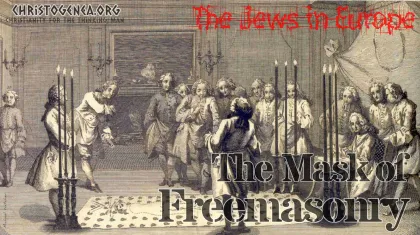
The Jews in Europe: The Mask of Freemasonry, Part 1
Some of the denizens of the Christogenea chat server have already scolded me for procrastinating, and forestalling a continued presentation of the Protocols of Satan. However I found it necessary to do so, because in the first 7 segments of the series we went to great lengths to demonstrate that The Protocols of the Learned Elders of Zion were indeed what they are believed to be by many of the so-called “conspiracy theorists”: a boastful outline of the plans of Jewry for the final subjugation and control over the nations of Christendom. Doing this, we showed, largely from the work of Nesta Webster, that many of the statements in the Protocols had been expressed throughout the literature of both members and founders of the various secret societies of 18th and 19th century Europe, as well as that of the early leaders of the Marxist Communists.
Doing all of this, we presented the thesis that the Jews were indeed behind the Protocols of Zion, as it is claimed, and that the secret societies were the primary vehicle through which the Jews had been able to execute the plan for world conquest which the Protocols represent. However before proceeding with a presentation of the Protocols themselves, we determined that it was necessary to provide some of the glue necessary in order to secure that thesis. So we presented the chapter on the Spanish Inquisition from E. Michael Jones’ book The Jewish Revolutionary Spirit and its Impact on World History, and we did that, in part, in order to show that the mentality of the Jews of Europe in the 15th century was exactly similar to the mentality of the Jews as it is exhibited in the Protocols of Zion. Then we presented anew the Reuchlin Affair from E. Michael Jones’ perspective, with sufficient of our own comments, first in order to better elucidate the Jewish influence behind the humanist factions of the Reformation, and then to show that the naive German fascination with the Kabbalah of the sort exhibited by Reuchlin was the opportunity which the Jews took advantage of to lure men into their secret societies.
Christogenea is reader supported. This month's support level is reflected in the graph below. See our Contact page for a mailing address and other ways to support Christogenea.
63%